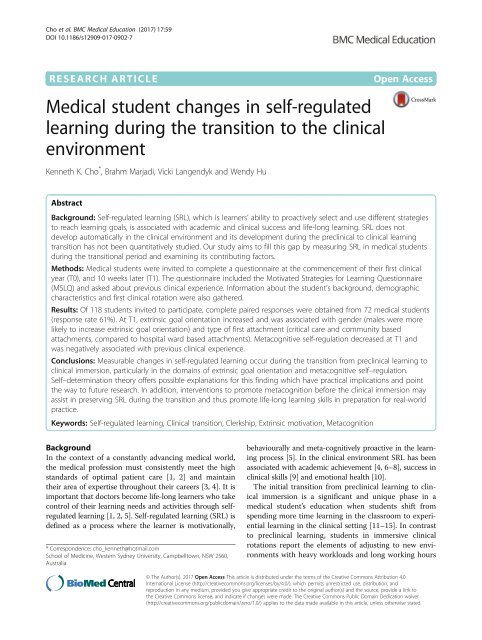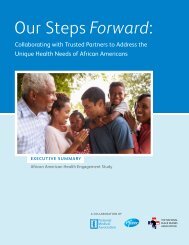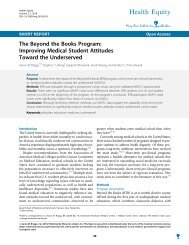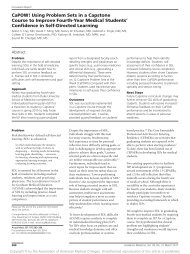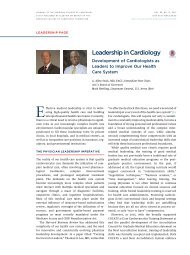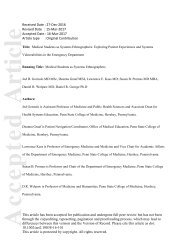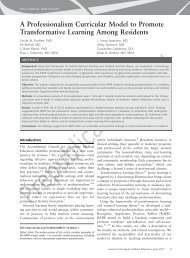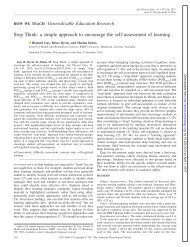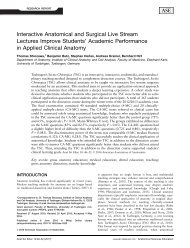Medical Students Adapt SRL in Clinics
You also want an ePaper? Increase the reach of your titles
YUMPU automatically turns print PDFs into web optimized ePapers that Google loves.
Cho et al. BMC <strong>Medical</strong> Education (2017) 17:59<br />
DOI 10.1186/s12909-017-0902-7<br />
RESEARCH ARTICLE<br />
Open Access<br />
<strong>Medical</strong> student changes <strong>in</strong> self-regulated<br />
learn<strong>in</strong>g dur<strong>in</strong>g the transition to the cl<strong>in</strong>ical<br />
environment<br />
Kenneth K. Cho * , Brahm Marjadi, Vicki Langendyk and Wendy Hu<br />
Abstract<br />
Background: Self-regulated learn<strong>in</strong>g (<strong>SRL</strong>), which is learners’ ability to proactively select and use different strategies<br />
to reach learn<strong>in</strong>g goals, is associated with academic and cl<strong>in</strong>ical success and life-long learn<strong>in</strong>g. <strong>SRL</strong> does not<br />
develop automatically <strong>in</strong> the cl<strong>in</strong>ical environment and its development dur<strong>in</strong>g the precl<strong>in</strong>ical to cl<strong>in</strong>ical learn<strong>in</strong>g<br />
transition has not been quantitatively studied. Our study aims to fill this gap by measur<strong>in</strong>g <strong>SRL</strong> <strong>in</strong> medical students<br />
dur<strong>in</strong>g the transitional period and exam<strong>in</strong><strong>in</strong>g its contribut<strong>in</strong>g factors.<br />
Methods: <strong>Medical</strong> students were <strong>in</strong>vited to complete a questionnaire at the commencement of their first cl<strong>in</strong>ical<br />
year (T0), and 10 weeks later (T1). The questionnaire <strong>in</strong>cluded the Motivated Strategies for Learn<strong>in</strong>g Questionnaire<br />
(MSLQ) and asked about previous cl<strong>in</strong>ical experience. Information about the student’s background, demographic<br />
characteristics and first cl<strong>in</strong>ical rotation were also gathered.<br />
Results: Of 118 students <strong>in</strong>vited to participate, complete paired responses were obta<strong>in</strong>ed from 72 medical students<br />
(response rate 61%). At T1, extr<strong>in</strong>sic goal orientation <strong>in</strong>creased and was associated with gender (males were more<br />
likely to <strong>in</strong>crease extr<strong>in</strong>sic goal orientation) and type of first attachment (critical care and community based<br />
attachments, compared to hospital ward based attachments). Metacognitive self-regulation decreased at T1 and<br />
was negatively associated with previous cl<strong>in</strong>ical experience.<br />
Conclusions: Measurable changes <strong>in</strong> self-regulated learn<strong>in</strong>g occur dur<strong>in</strong>g the transition from precl<strong>in</strong>ical learn<strong>in</strong>g to<br />
cl<strong>in</strong>ical immersion, particularly <strong>in</strong> the doma<strong>in</strong>s of extr<strong>in</strong>sic goal orientation and metacognitive self–regulation.<br />
Self–determ<strong>in</strong>ation theory offers possible explanations for this f<strong>in</strong>d<strong>in</strong>g which have practical implications and po<strong>in</strong>t<br />
the way to future research. In addition, <strong>in</strong>terventions to promote metacognition before the cl<strong>in</strong>ical immersion may<br />
assist <strong>in</strong> preserv<strong>in</strong>g <strong>SRL</strong> dur<strong>in</strong>g the transition and thus promote life-long learn<strong>in</strong>g skills <strong>in</strong> preparation for real-world<br />
practice.<br />
Keywords: Self-regulated learn<strong>in</strong>g, Cl<strong>in</strong>ical transition, Clerkship, Extr<strong>in</strong>sic motivation, Metacognition<br />
Background<br />
In the context of a constantly advanc<strong>in</strong>g medical world,<br />
the medical profession must consistently meet the high<br />
standards of optimal patient care [1, 2] and ma<strong>in</strong>ta<strong>in</strong><br />
their area of expertise throughout their careers [3, 4]. It is<br />
important that doctors become life-long learners who take<br />
control of their learn<strong>in</strong>g needs and activities through selfregulated<br />
learn<strong>in</strong>g [1, 2, 5]. Self-regulated learn<strong>in</strong>g (<strong>SRL</strong>) is<br />
def<strong>in</strong>ed as a process where the learner is motivationally,<br />
* Correspondence: cho_kenneth@hotmail.com<br />
School of Medic<strong>in</strong>e, Western Sydney University, Campbelltown, NSW 2560,<br />
Australia<br />
behaviourally and meta-cognitively proactive <strong>in</strong> the learn<strong>in</strong>g<br />
process [5]. In the cl<strong>in</strong>ical environment <strong>SRL</strong> has been<br />
associated with academic achievement [4, 6–8], success <strong>in</strong><br />
cl<strong>in</strong>ical skills [9] and emotional health [10].<br />
The <strong>in</strong>itial transition from precl<strong>in</strong>ical learn<strong>in</strong>g to cl<strong>in</strong>ical<br />
immersion is a significant and unique phase <strong>in</strong> a<br />
medical student’s education when students shift from<br />
spend<strong>in</strong>g more time learn<strong>in</strong>g <strong>in</strong> the classroom to experiential<br />
learn<strong>in</strong>g <strong>in</strong> the cl<strong>in</strong>ical sett<strong>in</strong>g [11–15]. In contrast<br />
to precl<strong>in</strong>ical learn<strong>in</strong>g, students <strong>in</strong> immersive cl<strong>in</strong>ical<br />
rotations report the elements of adjust<strong>in</strong>g to new environments<br />
with heavy workloads and long work<strong>in</strong>g hours<br />
© The Author(s). 2017 Open Access This article is distributed under the terms of the Creative Commons Attribution 4.0<br />
International License (http://creativecommons.org/licenses/by/4.0/), which permits unrestricted use, distribution, and<br />
reproduction <strong>in</strong> any medium, provided you give appropriate credit to the orig<strong>in</strong>al author(s) and the source, provide a l<strong>in</strong>k to<br />
the Creative Commons license, and <strong>in</strong>dicate if changes were made. The Creative Commons Public Doma<strong>in</strong> Dedication waiver<br />
(http://creativecommons.org/publicdoma<strong>in</strong>/zero/1.0/) applies to the data made available <strong>in</strong> this article, unless otherwise stated.
Cho et al. BMC <strong>Medical</strong> Education (2017) 17:59 Page 2 of 8<br />
[12, 16, 17], adapt<strong>in</strong>g to different expectations, forms of<br />
assessment and teach<strong>in</strong>g styles [12, 18], feel<strong>in</strong>g at times<br />
useless and uncerta<strong>in</strong> about their role [12, 19, 20] and<br />
adapt<strong>in</strong>g to a more self–directed learn<strong>in</strong>g style [16, 20, 21].<br />
Specifically, research suggests that despite the addition of<br />
cl<strong>in</strong>ical tutorials to the precl<strong>in</strong>ical curriculum, students<br />
dur<strong>in</strong>g the cl<strong>in</strong>ical transition face considerable challenges,<br />
ambiguity and uncerta<strong>in</strong>ty [12, 22, 23]. As well as opportunities,<br />
these experiences present potential disruptions to<br />
the development of the skills needed for life-long learn<strong>in</strong>g.<br />
However to our knowledge, no research has explored<br />
the changes <strong>in</strong> self -regulated learn<strong>in</strong>g that occur<br />
dur<strong>in</strong>g the <strong>in</strong>itial transition period from precl<strong>in</strong>ical to<br />
cl<strong>in</strong>ical immersion us<strong>in</strong>g a quantitative approach.<br />
We therefore aimed to measure the changes that occur<br />
<strong>in</strong> self-regulated learn<strong>in</strong>g dur<strong>in</strong>g the critical transition<br />
from pre-cl<strong>in</strong>ical to immersive cl<strong>in</strong>ical learn<strong>in</strong>g and associated<br />
factors. We hypothesized that changes <strong>in</strong> <strong>SRL</strong><br />
would occur, as the learn<strong>in</strong>g environment is a key factor<br />
affect<strong>in</strong>g <strong>SRL</strong> <strong>in</strong> many theoretical models [2, 24, 25].<br />
Our research questions were: “what are the changes <strong>in</strong><br />
<strong>SRL</strong> dur<strong>in</strong>g the transition to the cl<strong>in</strong>ical learn<strong>in</strong>g environment?”<br />
and “what factors are associated with that<br />
change?” Through these research questions we aimed to<br />
enhance our understand<strong>in</strong>g of medical student motivation<br />
and learn<strong>in</strong>g dur<strong>in</strong>g the cl<strong>in</strong>ical transitional period,<br />
which has implications on curricula and future research<br />
directions.<br />
Method<br />
Study sett<strong>in</strong>g<br />
The study participants were 3rd year medical students at<br />
Western Sydney University, Australia. The curriculum is a<br />
5-year undergraduate program. The first 2 years comprise<br />
of problem based learn<strong>in</strong>g <strong>in</strong> small groups with weekly<br />
cl<strong>in</strong>ical tutorials <strong>in</strong> hospital sett<strong>in</strong>gs. The f<strong>in</strong>al 3 years are<br />
based on a model of cl<strong>in</strong>ical immersion <strong>in</strong> rural and<br />
metropolitan hospitals as well as community based attachments.<br />
In the first cl<strong>in</strong>ical year (3rd year of the course)<br />
there are seven rotations <strong>in</strong> a year, where each rotation<br />
is of a 5-week duration: two medical, two surgical, two<br />
community (consist<strong>in</strong>g of community health service and<br />
general practice) and one critical care (consist<strong>in</strong>g of<br />
emergency department and anaesthetics) attachments.<br />
Study participants<br />
This study was conducted <strong>in</strong> 2015 with a cohort of students<br />
(n = 118) at the beg<strong>in</strong>n<strong>in</strong>g of first cl<strong>in</strong>ical year.<br />
Ethical approval was obta<strong>in</strong>ed from Western Sydney<br />
University (ID H9989).<br />
Data collection<br />
Consent<strong>in</strong>g students were <strong>in</strong>vited to complete a questionnaire<br />
at the <strong>in</strong>troductory lectures prior to the<br />
commencement of their first cl<strong>in</strong>ical placement (Time 0,<br />
T0). The survey was repeated after the first 10 weeks of<br />
cl<strong>in</strong>ical placements (Time 1, T1). Only those who<br />
responded at both T0 and T1 and where paired responses<br />
could be identified were <strong>in</strong>cluded <strong>in</strong> the analysis. The T1<br />
time of 10 weeks was chosen as the organizational psychology<br />
literature suggests newcomers learn, adjust and adapt<br />
to the job, roles and culture of a workplace rapidly <strong>in</strong> the<br />
first 1–2 months post-entry period [26–29], that the result<strong>in</strong>g<br />
adjustments are relatively stable [30–32] and that early<br />
adaptations are related to important outcomes for both<br />
organizations and new employees [29, 30, 33, 34].<br />
Motivated Strategies for Learn<strong>in</strong>g Questionnaire (MSLQ)<br />
The MSLQ is a validated <strong>in</strong>strument based upon the social<br />
cognitive theory of learn<strong>in</strong>g to measure <strong>SRL</strong> [35, 36].<br />
The <strong>in</strong>strument has been used <strong>in</strong> a wide range of population<br />
groups, from students <strong>in</strong> primary schools to those<br />
<strong>in</strong> higher education. Several studies have used the MSLQ<br />
as part of medical education research and have found<br />
associations between MSLQ scores and academic<br />
achievement [6, 37–39]. One prelim<strong>in</strong>ary study used the<br />
MSLQ to measure the changes <strong>in</strong> <strong>SRL</strong> of precl<strong>in</strong>ical<br />
medical students that occurred between the first and<br />
second year of their course [40].<br />
The MSLQ uses a 7-po<strong>in</strong>t Likert-type scale compris<strong>in</strong>g<br />
of 2 sections, motivation and learn<strong>in</strong>g strategies.<br />
The motivation section conta<strong>in</strong>s 31 items assess<strong>in</strong>g 3<br />
doma<strong>in</strong>s: goal orientation, self-belief about learn<strong>in</strong>g,<br />
and test-provoked anxiety. The learn<strong>in</strong>g section conta<strong>in</strong>s50itemsassess<strong>in</strong>g3doma<strong>in</strong>s:theuseofcognitive<br />
strategies, metacognitive strategies and resource management<br />
(Additional file 1: Appendix 1).<br />
First cl<strong>in</strong>ical rotation<br />
Data was extracted from student records and <strong>in</strong>cluded<br />
<strong>in</strong>formation about what the students’ first cl<strong>in</strong>ical attachment<br />
would be: medic<strong>in</strong>e, surgery, critical care or the<br />
community attachment.<br />
Participant background<br />
Demographic data such as age, gender and entry status<br />
were extracted from student records. Entry status categories<br />
<strong>in</strong>cluded school-leaver students who entered immediately<br />
after high school; non school-leaver students who<br />
started but have not f<strong>in</strong>ished another tertiary degree;<br />
graduate students who have completed another tertiary<br />
degree; and <strong>in</strong>ternational students. As part of the T0 questionnaire,<br />
students were asked whether they had any prior<br />
cl<strong>in</strong>ical experience other than the compulsory cl<strong>in</strong>ical<br />
medic<strong>in</strong>e tutorials dur<strong>in</strong>g the first 2 years.
Cho et al. BMC <strong>Medical</strong> Education (2017) 17:59 Page 3 of 8<br />
Data analysis<br />
For each subscale of the MSLQ, the data were categorized<br />
<strong>in</strong>to 3 categories: low scores (1.0 to
Cho et al. BMC <strong>Medical</strong> Education (2017) 17:59 Page 4 of 8<br />
Table 2 Change <strong>in</strong> the MSLQ from T 0 to T 1<br />
Section Subscale Number of participants, T0 Number of participants, T1 P values of<br />
Low score Medium score High score Low score Medium score High score<br />
T0-T1 difference<br />
Motivation Intr<strong>in</strong>sic Goal Orientation 0 27 45 0 19 53 0.061<br />
Extr<strong>in</strong>sic Goal Orientation 1 45 26 1 35 36 0.033 a<br />
Task Value 0 5 67 0 8 64 0.180<br />
Control of Learn<strong>in</strong>g Beliefs 0 14 58 0 15 57 0.782<br />
Self-Efficacy for Learn<strong>in</strong>g 1 42 29 1 37 34 0.275<br />
and Performance<br />
Test Anxiety 3 46 23 4 43 25 0.827<br />
Learn<strong>in</strong>g Strategies Rehearsal 1 58 13 3 46 23 0.074<br />
Resource<br />
Management<br />
Strategies<br />
Elaboration 0 29 43 0 32 40 0.532<br />
Organization 0 36 36 0 37 35 0.827<br />
Critical Th<strong>in</strong>k<strong>in</strong>g 2 58 12 3 52 17 0.317<br />
Metacognitive<br />
0 54 18 0 66 6 0.001 b<br />
Self-regulation<br />
Time and Study<br />
Environment<br />
1 47 24 0 53 19 0.317<br />
Effort Regulation 1 48 23 0 47 25 0.532<br />
Peer Learn<strong>in</strong>g 9 47 16 7 42 23 0.072<br />
Help Seek<strong>in</strong>g 5 51 16 4 51 17 0.655<br />
a Statistically significant at the 0.05 level (Marg<strong>in</strong>al Homogeneity Test)<br />
b Statistically significant at the 0.01 level (Marg<strong>in</strong>al Homogeneity Test)<br />
were gender (male vs female) and first attachment (critical<br />
care and the community attachment vs medic<strong>in</strong>e/surgery).<br />
The s<strong>in</strong>gle factor associated with a decrease <strong>in</strong> metacognitive<br />
self-regulation was previous cl<strong>in</strong>ical experience (no experience<br />
vs experience).<br />
Extr<strong>in</strong>sic motivation<br />
Accord<strong>in</strong>g to the MSLQ, extr<strong>in</strong>sic goal orientation is<br />
def<strong>in</strong>ed as the degree to which a student perceives the<br />
importance of issues that are not directly related to participat<strong>in</strong>g<br />
<strong>in</strong> the task itself [41]. This <strong>in</strong>cludes grades,<br />
rewards and reputation. Studies from the transitions<br />
literature provide an explanation as to why transition<strong>in</strong>g<br />
clerkship students <strong>in</strong>crease <strong>in</strong> extr<strong>in</strong>sic motivation, and<br />
how this may relate to their gender and first attachment.<br />
As opposed to the precl<strong>in</strong>ical years where students are<br />
assessed <strong>in</strong> formal exam<strong>in</strong>ation sett<strong>in</strong>gs, the literature suggests<br />
students <strong>in</strong> immersive cl<strong>in</strong>ical sett<strong>in</strong>gs feel constantly<br />
<strong>in</strong>formally assessed by their supervisors. [42–46]. These<br />
studies suggest clerkship students are more extr<strong>in</strong>sically<br />
motivated <strong>in</strong> their learn<strong>in</strong>g as impress<strong>in</strong>g their supervisor<br />
may lead to further experiential learn<strong>in</strong>g opportunities,<br />
better evaluations and future career prospects [42–46].<br />
This also expla<strong>in</strong>s why <strong>in</strong> our study, compared to the transition<strong>in</strong>g<br />
students on the ward-based attachments, the<br />
students whose first rotations <strong>in</strong>volved 1:1 supervision<br />
(the critical care and the community attachments) were<br />
more likely to <strong>in</strong>crease <strong>in</strong> extr<strong>in</strong>sic goal orientation.<br />
In regards to gender, our study found that male students<br />
are more likely to develop an <strong>in</strong>crease <strong>in</strong> extr<strong>in</strong>sic goal<br />
orientation with qualitative studies from the transitions<br />
Table 3 Results of Regression Analysis<br />
Doma<strong>in</strong> Factors Category Odds Ratio (95% CI) P value<br />
Extr<strong>in</strong>sic Goal Orientation a<br />
Gender Male vs Female 4.1 (1.234–13.526) 0.021<br />
First Attachment Critical Care vs Medic<strong>in</strong>e/Surgery 8.7 (1.570–48.543) 0.013<br />
First Attachment Community attachment vs Medic<strong>in</strong>e/Surgery 3.8 (1.052–14.015) 0.042<br />
Metacognitive Self-Regulation b<br />
Previous cl<strong>in</strong>ical experience Experience vs No experience 5.0 (1.123–22.170) 0.035<br />
a Non-significant factors <strong>in</strong> the model were “entry status” and “previous cl<strong>in</strong>ical experience”<br />
b Non-significant factors <strong>in</strong> the model were “entry status”, “gender” and “first cl<strong>in</strong>ical attachment
Cho et al. BMC <strong>Medical</strong> Education (2017) 17:59 Page 5 of 8<br />
literature support<strong>in</strong>g our f<strong>in</strong>d<strong>in</strong>g [47, 48]. Supervisors<br />
may have gender-biased expectations of performance<br />
which lead to female medical students receiv<strong>in</strong>g less<br />
pressure [47].<br />
A more nuanced explanation as to why students experience<br />
an <strong>in</strong>crease <strong>in</strong> extr<strong>in</strong>sic goal orientation dur<strong>in</strong>g<br />
the transition to the cl<strong>in</strong>ical environment can be provided<br />
by the self-determ<strong>in</strong>ation theory (SDT) of Ryan<br />
and Deci, which is a more recent model of motivation to<br />
the MSLQ. Researchers widely agree that when possible,<br />
<strong>in</strong>tr<strong>in</strong>sic motivation is preferred as it has been l<strong>in</strong>ked<br />
with more enjoyment [49], more engagement [50, 51]<br />
and better learn<strong>in</strong>g [52, 53]. Accord<strong>in</strong>g to Ryan and<br />
Deci, for extr<strong>in</strong>sic motivation to develop <strong>in</strong>to <strong>in</strong>tr<strong>in</strong>sic<br />
motivation, the student must be <strong>in</strong>terested <strong>in</strong> the task at<br />
hand as well as have their needs of competence, autonomy<br />
and relatedness met [54]. Accord<strong>in</strong>g to SDT, competence<br />
refers to the experience of behaviour be<strong>in</strong>g<br />
effectively enacted. The feel<strong>in</strong>g of competence is supported<br />
when activities are optimally challeng<strong>in</strong>g, thereby<br />
allow<strong>in</strong>g students to test and expand their academic<br />
capabilities, or when feedback promotes feel<strong>in</strong>gs of efficacy<br />
or eventual mastery [49]. Autonomy occurs when a<br />
student’s behaviour is aligned with their authentic <strong>in</strong>terests<br />
or <strong>in</strong>tegrated values and desires, and when the<br />
student fully endorses the actions they engaged <strong>in</strong> or the<br />
values they expressed [53, 55]. Autonomy is lost when<br />
the student feels they are compelled to behave <strong>in</strong> specific<br />
ways regardless of their own values or <strong>in</strong>terests [55]. The<br />
need for relatedness refers to the tendency for people to<br />
<strong>in</strong>ternalise and adopt the values and the practices of<br />
those they feel connected to or desire a connection with,<br />
and from contexts where they feel belong<strong>in</strong>g [49].<br />
Relatedness is supported when a teacher genu<strong>in</strong>ely likes,<br />
respects and values the student [49]. Accord<strong>in</strong>g to SDT,<br />
if the needs of competence, autonomy and relatedness<br />
are not met, any motivation will be extr<strong>in</strong>sic as opposed<br />
to <strong>in</strong>tr<strong>in</strong>sic <strong>in</strong> nature.<br />
When analysed through the frame of SDT, previous<br />
studies <strong>in</strong> the transitions literature suggests medical students<br />
<strong>in</strong> the transition period may experience a lack of<br />
all three needs: students feel they lack competence, autonomy<br />
and relatedness [11, 16, 46, 56–59]. Radcliffe<br />
and Lester found that dur<strong>in</strong>g the transition students had<br />
experiences “of feel<strong>in</strong>g useless [and] unable to contribute<br />
to patient care because they had <strong>in</strong>sufficient knowledge<br />
or skills” [lack of competence] [11]. The lack of competence<br />
felt by medical students dur<strong>in</strong>g the cl<strong>in</strong>ical transition<br />
is supported by other studies [58, 59]. In regards to<br />
autonomy, studies suggest that students feel they often<br />
complete tedious tasks such as paperwork at the request<br />
of their consultant physician <strong>in</strong>stead of engag<strong>in</strong>g <strong>in</strong> tasks<br />
more aligned with their <strong>in</strong>terests and values, such as<br />
talk<strong>in</strong>g to patients [16, 46]. In regards to relatedness,<br />
students may feel they are neither be<strong>in</strong>g genu<strong>in</strong>ely valued<br />
nor respected, with older studies suggest<strong>in</strong>g that levels of<br />
abuse (verbal, physical, sexual and academic) experienced<br />
by medical students are high (50–93%) [56, 60–62].<br />
Newer research suggest some forms of extr<strong>in</strong>sic motivation<br />
may be similar to <strong>in</strong>tr<strong>in</strong>sic motivation [53]. It is<br />
important to state that there are—accord<strong>in</strong>g to self-determ<strong>in</strong>ation<br />
theory—4 types of extr<strong>in</strong>sic motivation (externally<br />
regulated, <strong>in</strong>trojected, identified and <strong>in</strong>tegrated).<br />
Externally regulated motivation (where behaviours are<br />
enacted to obta<strong>in</strong> a reward or to avoid punishment) and<br />
<strong>in</strong>trojected motivation (whereby behaviours are enacted <strong>in</strong><br />
order to primarily protect one’s ego)arebelievedtobe<br />
shallower forms of motivation whose behaviours are poorly<br />
ma<strong>in</strong>ta<strong>in</strong>ed once the controll<strong>in</strong>g extr<strong>in</strong>sic factors have been<br />
removed [54]. Identified motivation (where behaviours are<br />
enacted because of the perceived value of the task) and <strong>in</strong>tegrated<br />
motivation (where behaviours are enacted because<br />
they are aligned with other aspects of self) are believed to<br />
be deeper forms of motivation, whose behaviour stems<br />
from more autonomous motivation [53, 54]. The dist<strong>in</strong>ction<br />
between the former two and latter two types of motivations<br />
is critical because studies <strong>in</strong> educational psychology<br />
suggest that higher amounts of autonomous extr<strong>in</strong>sic<br />
motivation are l<strong>in</strong>ked with academic success, quicker<br />
adjustment, greater well-be<strong>in</strong>g, decreased anxiety and more<br />
<strong>in</strong>tr<strong>in</strong>sic enjoyment [49, 63–65] which are all highly relevant<br />
to the transitions period. Thus it may be well worth<br />
for the MSLQ extr<strong>in</strong>sic motivation subscale to be revised<br />
so that it can dist<strong>in</strong>guish between each of the different<br />
types of extr<strong>in</strong>sic motivation. Practically this is important,<br />
because if the <strong>in</strong>creases <strong>in</strong> extr<strong>in</strong>sic motivation are not<br />
beneficial, then curriculum designers could structure<br />
first attachments so that transition<strong>in</strong>g students feel less<br />
monitored and more autonomous <strong>in</strong> their learn<strong>in</strong>g.<br />
Metacognitive self-regulation<br />
The MSLQ def<strong>in</strong>es metacognition as the awareness and<br />
control of cognition that can be broken down <strong>in</strong>to three<br />
general processes: plann<strong>in</strong>g, monitor<strong>in</strong>g, and regulat<strong>in</strong>g<br />
[41]. Plann<strong>in</strong>g activities <strong>in</strong>clude goal sett<strong>in</strong>g and reflect<strong>in</strong>g<br />
on prior knowledge that make organiz<strong>in</strong>g and comprehend<strong>in</strong>g<br />
the material easier. Monitor<strong>in</strong>g activities<br />
<strong>in</strong>clude the track<strong>in</strong>g of attention and self-test<strong>in</strong>g. Regulat<strong>in</strong>g<br />
activities <strong>in</strong>clude adjust<strong>in</strong>g one’s cognitive and<br />
behavioural activities.<br />
In our study, previous cl<strong>in</strong>ical experience was associated<br />
with a decrease <strong>in</strong> metacognitive self-regulation.<br />
This f<strong>in</strong>d<strong>in</strong>g was surpris<strong>in</strong>g as we hypothesised that<br />
students with previous cl<strong>in</strong>ical experience would f<strong>in</strong>d the<br />
transition period less stressful and thus need to use less<br />
cognitive resources to adapt, spend<strong>in</strong>g more of their cognitive<br />
resources on metacognition. These hypotheses are<br />
consistent with previous transitions literature suggest<strong>in</strong>g
Cho et al. BMC <strong>Medical</strong> Education (2017) 17:59 Page 6 of 8<br />
that prior cl<strong>in</strong>ical experience leads to a smoother transition<br />
[66–68] and potentially less cognitive load [69]. There<br />
is no clear reason for our f<strong>in</strong>d<strong>in</strong>gs from this research.<br />
The decrease <strong>in</strong> metacognitive self-regulation has realworld<br />
importance. Studies suggest that metacognition has<br />
a positive association with academic performance [35] and<br />
surgical skills acquisition [70], a negative association with<br />
procrast<strong>in</strong>ation [4] and depression [9], and is important<br />
for cl<strong>in</strong>ical reason<strong>in</strong>g, decision mak<strong>in</strong>g [71, 72] and the<br />
cont<strong>in</strong>uous process of life-long learn<strong>in</strong>g [73, 74]. Furthermore,<br />
positive metacognitive abilities have been associated<br />
with a decreased level of perceived stress [75]. On a<br />
conceptual level, because clerkships are based upon the<br />
pr<strong>in</strong>ciples of experiential learn<strong>in</strong>g, the success of clerkship<br />
depends <strong>in</strong> part on a student’s capacity for reflective practice<br />
and accurate self-assessment [76, 77]. Therefore metacognitive<br />
self-regulation is critical for students to be able<br />
to learn effectively, especially dur<strong>in</strong>g the immersive<br />
cl<strong>in</strong>ical years as studies suggest that the student <strong>in</strong>teractions<br />
with patients are rarely observed directly by cl<strong>in</strong>ical<br />
teachers [78, 79].<br />
Fortunately, literature suggests that <strong>in</strong>terventions can<br />
<strong>in</strong>crease metacognitive processes. Chew showed a simple<br />
metacognitive checklist could facilitate metacognition <strong>in</strong><br />
cl<strong>in</strong>ical decision-mak<strong>in</strong>g [80], Sobral showed that a 30 h<br />
learn<strong>in</strong>g skills course for medical students could <strong>in</strong>crease<br />
levels of reflection, one subset of metacognition [7] and<br />
Tanner suggests explicitly teach<strong>in</strong>g metacognition may<br />
be efficacious [81]. With<strong>in</strong> the hospital, studies also<br />
suggest supervisors can <strong>in</strong>crease the metacognition of<br />
their students by provid<strong>in</strong>g feedback [82], by “th<strong>in</strong>k<strong>in</strong>galoud”—which<br />
<strong>in</strong>volves vocaliz<strong>in</strong>g their thought processes<br />
<strong>in</strong>volved <strong>in</strong> cl<strong>in</strong>ical reason<strong>in</strong>g [83] and by emphasiz<strong>in</strong>g the<br />
importance of learn<strong>in</strong>g over outcome [84]. Our research<br />
suggests a metacognitive <strong>in</strong>tervention before or dur<strong>in</strong>g the<br />
transition may be valuable so that students can experience<br />
less stress and optimize their learn<strong>in</strong>g.<br />
Limitations<br />
Our study had several limitations. Due to the s<strong>in</strong>gle<strong>in</strong>stitution<br />
design of the study, care must be taken not to<br />
over <strong>in</strong>terpret our f<strong>in</strong>d<strong>in</strong>gs particularly with respect to<br />
transitions <strong>in</strong> different medical schools. Furthermore our<br />
study focussed on a s<strong>in</strong>gle transition and thus transferability<br />
to other cohorts is limited. However, as the cl<strong>in</strong>ical<br />
transition structure is the same across the years, it is<br />
possible that similar trends may exist <strong>in</strong> other cohorts. A<br />
questionnaire was our ma<strong>in</strong> data collection tool, therefore<br />
social desirability bias may be present. However the<br />
MSLQ has reasonable psychometric properties [34]. With<br />
our factor “first attachment” there is likely to be <strong>in</strong>herent<br />
differences with<strong>in</strong> rotations. For example, two medical rotations<br />
could have different supervisor–student dynamics.<br />
Despite this likely diversity of experiences with<strong>in</strong> the<br />
attachments, a significant effect of first attachment was<br />
still found for extr<strong>in</strong>sic motivation. The results of our<br />
study had wide confidence <strong>in</strong>tervals and negative results<br />
and therefore a larger study should be conducted to get a<br />
clearer <strong>in</strong>sight <strong>in</strong>to the transitional period. F<strong>in</strong>ally, due to<br />
the response rate we obta<strong>in</strong>ed, a possibility of selection<br />
bias and type 2 error exists.<br />
Conclusion<br />
Our study explored the changes <strong>in</strong> the <strong>SRL</strong> of medical<br />
students dur<strong>in</strong>g the transition to immersive cl<strong>in</strong>ical<br />
learn<strong>in</strong>g us<strong>in</strong>g a quantitative approach. We found that<br />
10 weeks after transition<strong>in</strong>g to cl<strong>in</strong>ical learn<strong>in</strong>g, students<br />
significantly <strong>in</strong>creased <strong>in</strong> extr<strong>in</strong>sic goal orientation and<br />
significantly decreased <strong>in</strong> metacognitive self-regulation.<br />
Factors associated with the <strong>in</strong>crease <strong>in</strong> extr<strong>in</strong>sic goal<br />
orientation were gender and first cl<strong>in</strong>ical attachment,<br />
with the style of cl<strong>in</strong>ical supervision be<strong>in</strong>g a possible<br />
explanation for the observed differences between attachments.<br />
The sole factor associated with the decrease <strong>in</strong><br />
metacognitive self-regulation was previous cl<strong>in</strong>ical experience.<br />
Although a larger study with multiple cohorts<br />
from multiple <strong>in</strong>stitutions is necessary to improve the<br />
generalizability of our f<strong>in</strong>d<strong>in</strong>gs, our study suggests that<br />
future research could further explore the transition to<br />
cl<strong>in</strong>ical learn<strong>in</strong>g through the lens of SDT, as well as <strong>in</strong>terventions<br />
to enhance metacognition and thus learn<strong>in</strong>g<br />
dur<strong>in</strong>g the transition period.<br />
Additional file<br />
Additional file 1: Appendix 1 The Motivated Strategies for Learn<strong>in</strong>g<br />
Questionnaire (MSLQ). Description: The MSLQ, a validated <strong>in</strong>strument<br />
based upon the social cognitive theory of learn<strong>in</strong>g to measure <strong>SRL</strong>.<br />
(DOCX 52 kb)<br />
Abbreviations<br />
MSLQ: Motivated strategies for learn<strong>in</strong>g questionnaire; SDT: Self<br />
determ<strong>in</strong>ation theory; <strong>SRL</strong>: Self-regulated learn<strong>in</strong>g<br />
Fund<strong>in</strong>g<br />
There was no fund<strong>in</strong>g for this research project.<br />
Availability of data and materials<br />
The datasets used <strong>in</strong> the current study is available from the correspond<strong>in</strong>g<br />
author on reasonable request.<br />
Authors’ contributions<br />
All authors were <strong>in</strong>volved <strong>in</strong> design<strong>in</strong>g the study. BM and KC were <strong>in</strong>volved<br />
<strong>in</strong> the data analysis of the project. WH, KC and VL were <strong>in</strong>volved <strong>in</strong><br />
<strong>in</strong>terpret<strong>in</strong>g the data. All authors were <strong>in</strong>volved <strong>in</strong> the edit<strong>in</strong>g process and<br />
approved the f<strong>in</strong>al manuscript.<br />
Compet<strong>in</strong>g <strong>in</strong>terests<br />
The authors declare that there are no compet<strong>in</strong>g <strong>in</strong>terests.<br />
Consent for publication<br />
Not applicable.
Cho et al. BMC <strong>Medical</strong> Education (2017) 17:59 Page 7 of 8<br />
Ethics approval and consent to participate<br />
Ethics approval and consent was obta<strong>in</strong>ed from Western Sydney University<br />
(ID H9989). Informed written consent for publication was obta<strong>in</strong>ed <strong>in</strong> writ<strong>in</strong>g<br />
from all participants <strong>in</strong> the study.<br />
Publisher’s Note<br />
Spr<strong>in</strong>ger Nature rema<strong>in</strong>s neutral with regard to jurisdictional claims <strong>in</strong><br />
published maps and <strong>in</strong>stitutional affiliations.<br />
Received: 9 September 2016 Accepted: 14 March 2017<br />
References<br />
1. Lucieer SM, Jonker L, Visscher C, Rikers RMJP, Themmen APN. Self-regulated<br />
learn<strong>in</strong>g and academic performance <strong>in</strong> medical education. Med Teach.<br />
2016;38(6):585–93.<br />
2. Brydges R, Butler D. A reflective analysis of medical education research on<br />
self-regulation <strong>in</strong> learn<strong>in</strong>g and practice. Med Educ. 2012;46(1):71–9.<br />
3. Greveson GC, Spencer JA. Self-directed learn<strong>in</strong>g–the importance of<br />
concepts and contexts. Med Educ. 2005;39(4):348–9.<br />
4. Art<strong>in</strong>o Jr AR, Dong T, DeZee KJ, Gilliland WR, Waechter DM, Cruess D, et al.<br />
Achievement goal structures and self-regulated learn<strong>in</strong>g: relationships and<br />
changes <strong>in</strong> medical school. Acad Med. 2012;87(10):1375–81.<br />
5. Zimmerman BJ. Becom<strong>in</strong>g a self-regulated learner: Which are the key<br />
subprocesses? Contemp Educ Psychol. 1986;11(4):307–13.<br />
6. Turan S, Konan A. Self-regulated learn<strong>in</strong>g strategies used <strong>in</strong> surgical<br />
clerkship and the relationship with cl<strong>in</strong>ical achievement. J Surg Educ. 2012;<br />
69(2):218–25.<br />
7. Song HS, Kalet AL, Plass JL. Assess<strong>in</strong>g medical students’ self-regulation as<br />
aptitude <strong>in</strong> computer-based learn<strong>in</strong>g. Adv Health Sci Educ. 2011;16(1):97–107.<br />
8. Sobral DT. An appraisal of medical students’ reflection-<strong>in</strong>-learn<strong>in</strong>g. Med<br />
Educ. 2000;34(3):182–7.<br />
9. Cleary TJ, Sandars J. Assess<strong>in</strong>g self-regulatory processes dur<strong>in</strong>g cl<strong>in</strong>ical skill<br />
performance: A pilot study. Med Teach. 2011;33(7):e368–e74.<br />
10. Van Nguyen H, Laohasiriwong W, Saengsuwan J, Th<strong>in</strong>khamrop B, Wright P.<br />
The relationships between the use of self-regulated learn<strong>in</strong>g strategies and<br />
depression among medical students: An accelerated prospective cohort<br />
study. Psychol Health Med. 2015;20(1):59–70.<br />
11. Dubé TV, Sch<strong>in</strong>ke RJ, Strasser R, Couper I, Lightfoot NE. Transition processes<br />
through a longitud<strong>in</strong>al <strong>in</strong>tegrated clerkship: a qualitative study of medical<br />
students’ experiences. Med Educ. 2015;49(10):1028–37.<br />
12. Radcliffe C, Lester H. Perceived stress dur<strong>in</strong>g undergraduate medical<br />
tra<strong>in</strong><strong>in</strong>g: a qualitative study. Med Educ. 2003;37(1):32–8.<br />
13. Haglund ME, aan het Rot M, Cooper NS, Nestadt PS, Muller D, Southwick<br />
SM, et al. Resilience <strong>in</strong> the third year of medical school: a prospective study<br />
of the associations between stressful events occurr<strong>in</strong>g dur<strong>in</strong>g cl<strong>in</strong>ical<br />
rotations and student well-be<strong>in</strong>g. Acad Med. 2009;84(2):258–68.<br />
14. Gaufberg EH, Batalden M, Sands R, Bell SK. The hidden curriculum: what can<br />
we learn from third-year medical student narrative reflections? Acad Med.<br />
2010;85(11):1709–16.<br />
15. Treadway K, Chatterjee N. Into the water–the cl<strong>in</strong>ical clerkships. New Engl J<br />
Med. 2011;364(13):1190–3.<br />
16. Pr<strong>in</strong>ce KJ, Boshuizen H, Van Der Vleuten CP, Scherpbier AJ. <strong>Students</strong>’<br />
op<strong>in</strong>ions about their preparation for cl<strong>in</strong>ical practice. Med Edu. 2005;39(7):<br />
704–12.<br />
17. Pr<strong>in</strong>ce KJAH, van de Wiel M, Scherpbier AJJA, Cess PM, Boshuizen HPA. A<br />
qualitative analysis of the transition from theory to practice <strong>in</strong><br />
undergraduate tra<strong>in</strong><strong>in</strong>g <strong>in</strong> a PBL-medical school. Adv Health Sci Educ. 2000;<br />
5(2):105–16.<br />
18. Remmen R, Denekens J, Scherpbier A, Hermann I, Van Der Vleuten C, Royen<br />
PV, et al. An evaluation study of the didactic quality of clerkships. Med Educ.<br />
2000;34(6):460–4.<br />
19. Pitkala K, Mantyranta T. Professional socialization revised: medical students’<br />
own conceptions related to adoption of the future physician’s role–a<br />
qualitative study. Med Teach. 2009;25(2):155-160<br />
20. Seabrook MA. Cl<strong>in</strong>ical students’ <strong>in</strong>itial reports of the educational climate <strong>in</strong> a<br />
s<strong>in</strong>gle medical school. Med Educ. 2004;38(6):659–69.<br />
21. White CB. Smooth<strong>in</strong>g out transitions: How pedagogy <strong>in</strong>fluences medical<br />
students’ achievement of self-regulated learn<strong>in</strong>g goals. Adv Health Sci Educ.<br />
2007;12(3):279–97.<br />
22. Teunissen PW, Westerman M. Opportunity or threat: the ambiguity of the<br />
consequences of transitions <strong>in</strong> medical education. Med Educ. 2011;45(1):51–9.<br />
23. O’Brien B, Cooke M, Irby DM. Perceptions and attributions of third-year<br />
student struggles <strong>in</strong> clerkships: do students and clerkship directors agree?<br />
Acad Med. 2007;82(10):970–8.<br />
24. Zimmerman BJ, Schunk DH. Self-regulated learn<strong>in</strong>g and academic<br />
achievement: Theoretical perspectives. New York: Lawrence Erlbaum<br />
Associates; 2001.<br />
25. Durn<strong>in</strong>g SJ, Cleary TJ, Sandars J, Hemmer P, Kokotailo P, Art<strong>in</strong>o AR.<br />
Perspective: view<strong>in</strong>g “strugglers” through a different lens: How a selfregulated<br />
learn<strong>in</strong>g perspective can help medical educators with assessment<br />
and remediation. Acad Med. 2011;86(4):488–95.<br />
26. Chan D, Schmitt N. Inter<strong>in</strong>dividual differences <strong>in</strong> <strong>in</strong>tra<strong>in</strong>dividual changes<br />
<strong>in</strong> proactivity dur<strong>in</strong>g organizational entry: a latent growth model<strong>in</strong>g<br />
approach to understand<strong>in</strong>g newcomer adaptation. J Appl Psychol. 2000;<br />
85(2):190.<br />
27. Chen G, Klimoski RJ. The impact of expectations on newcomer performance<br />
<strong>in</strong> teams as mediated by work characteristics, social exchanges, and<br />
empowerment. Acad Manage J. 2003;46(5):591–607.<br />
28. Cooper‐Thomas H, Anderson N. Newcomer adjustment: The relationship<br />
between organizational socialization tactics, <strong>in</strong>formation acquisition and<br />
attitudes. J Occup Organ Psychol. 2002;75(4):423–37.<br />
29. Cooper‐Thomas HD, Anderson N. Organizational socialization: A field study<br />
<strong>in</strong>to socialization success and rate. Int J Select Assess. 2005;13(2):116–28.<br />
30. Morrison EW. Longitud<strong>in</strong>al study of the effects of <strong>in</strong>formation seek<strong>in</strong>g on<br />
newcomer socialization. J Appl Psychol. 1993;78(2):173.<br />
31. Ostroff C, Kozlowski SW. Organizational socialization as a learn<strong>in</strong>g process:<br />
The role of <strong>in</strong>formation acquisition. Pers Psychol. 1992;45(4):849–74.<br />
32. Ashforth BE, Saks AM. Work-role transitions: A longitud<strong>in</strong>al exam<strong>in</strong>ation of<br />
the Nicholson model. J Occup Organ Psychol. 1995;68(2):157–75.<br />
33. Allen NJ, Meyer JP. The measurement and antecedents of affective,<br />
cont<strong>in</strong>uance and normative commitment to the organization. J Occup<br />
Psychol. 1990;63(1):1–18.<br />
34. Saks AM, Ashforth BE. Organizational socialization: Mak<strong>in</strong>g sense of the<br />
past and present as a prologue for the future. J Vocat Behav. 1997;<br />
51(2):234–79.<br />
35. P<strong>in</strong>trich PR, Smith DA, García T, McKeachie WJ. Reliability and predictive<br />
validity of the Motivated Strategies for Learn<strong>in</strong>g Questionnaire (MSLQ). Educ<br />
Psychol Meas. 1993;53(3):801–13.<br />
36. P<strong>in</strong>trich PR, De Groot EV. Motivational and self-regulated learn<strong>in</strong>g<br />
components of classroom academic performance. J Educ Psychol. 1990;<br />
82(1):33.<br />
37. Stegers‐Jager KM, Cohen‐Schotanus J, Themmen AP. Motivation, learn<strong>in</strong>g<br />
strategies, participation and medical school performance. Med Educ. 2012;<br />
46(7):678–88.<br />
38. Cook DA, Thompson WG, Thomas KG. The motivated strategies for learn<strong>in</strong>g<br />
questionnaire: score validity among medic<strong>in</strong>e residents. Med Educ. 2011;<br />
45(12):1230–40.<br />
39. Pizzimenti MA, Axelson RD. Assess<strong>in</strong>g student engagement and selfregulated<br />
learn<strong>in</strong>g <strong>in</strong> a medical gross anatomy course. Anat Sci Educ. 2015;<br />
8(2):104–10.<br />
40. Kim KJ, Jang HW. Changes <strong>in</strong> medical students’ motivation and selfregulated<br />
learn<strong>in</strong>g: a prelim<strong>in</strong>ary study. Int J Med Educ. 2015;6:213–5.<br />
41. P<strong>in</strong>trich PR. A manual for the use of the Motivated Strategies for Learn<strong>in</strong>g<br />
Questionnaire (MSLQ). 1991.<br />
42. Al Kadri HM, Al-Moamary MS, Elzubair M, Magzoub ME, AlMutairi A, Roberts<br />
C, et al. Explor<strong>in</strong>g factors affect<strong>in</strong>g undergraduate medical students’ study<br />
strategies <strong>in</strong> the cl<strong>in</strong>ical years: a qualitative study. Adv Health Sci Educ. 2011;<br />
16(5):553–67.<br />
43. Han H, Roberts NK, Korte R. Learn<strong>in</strong>g <strong>in</strong> the real place: medical students’<br />
learn<strong>in</strong>g and socialization <strong>in</strong> clerkships at one medical school. Acad Med.<br />
2015;90(2):231–9.<br />
44. Al-Kadri HM, Al-Kadi MT, Van Der Vleuten CP. Workplace-based assessment<br />
and students’ approaches to learn<strong>in</strong>g: a qualitative <strong>in</strong>quiry. Med Teach.<br />
2013;35 Suppl 1:S31–8.<br />
45. Lempp H, Seale C. The hidden curriculum <strong>in</strong> undergraduate medical<br />
education: qualitative study of medical students’ perceptions of teach<strong>in</strong>g.<br />
BMJ. 2004;329(7469):770–3.<br />
46. White CB, Kumagai AK, Ross PT, Fantone JC. A qualitative exploration of<br />
how the conflict between the formal and <strong>in</strong>formal curriculum <strong>in</strong>fluences<br />
student values and behaviors. Acad Med. 2009;84(5):597–603.
Cho et al. BMC <strong>Medical</strong> Education (2017) 17:59 Page 8 of 8<br />
47. Babaria P, Abed<strong>in</strong> S, Nunez-Smith M. The effect of gender on the cl<strong>in</strong>ical<br />
clerkship experiences of female medical students: Results from a qualitative<br />
study. Acad Med. 2009;84(7):859–66.<br />
48. Hill E, Vaughan S. The only girl <strong>in</strong> the room: how paradigmatic trajectories<br />
deter female students from surgical careers. Med Educ. 2013;47(6):547–56.<br />
49. Niemiec CP, Ryan RM. Autonomy, competence, and relatedness <strong>in</strong> the<br />
classroom Apply<strong>in</strong>g self-determ<strong>in</strong>ation theory to educational practice. Theor<br />
Res Educ. 2009;7(2):133–44.<br />
50. Reeve J, Jang H, Carrell D, Jeon S, Barch J. Enhanc<strong>in</strong>g students’ engagement by<br />
<strong>in</strong>creas<strong>in</strong>g teachers’ autonomy support. Motiv Emotion. 2004;28(2):147–69.<br />
51. Reeve J. Self-determ<strong>in</strong>ation theory applied to educational sett<strong>in</strong>gs. In: Deci<br />
EL, Ryan RM, editors. Handbook of self-determ<strong>in</strong>ation research. Rochester:<br />
University of Rochester Press; 2002. p. 470.<br />
52. Amabile TM. Creativity <strong>in</strong> context: Update to“the social psychology of<br />
creativity.” Boulder: Westview press; 1996.<br />
53. Ryan RM, Deci EL. Self-determ<strong>in</strong>ation theory and the facilitation of <strong>in</strong>tr<strong>in</strong>sic<br />
motivation, social development, and well-be<strong>in</strong>g. Am Psychol. 2000;55(1):68.<br />
54. Ryan RM, Deci EL. Intr<strong>in</strong>sic and extr<strong>in</strong>sic motivations: Classic def<strong>in</strong>itions and<br />
new directions. Contemp Educ Psychol. 2000;25(1):54–67.<br />
55. Chirkov V, Ryan RM, Kim Y, Kaplan U. Differentiat<strong>in</strong>g autonomy from<br />
<strong>in</strong>dividualism and <strong>in</strong>dependence: a self-determ<strong>in</strong>ation theory perspective<br />
on <strong>in</strong>ternalization of cultural orientations and well-be<strong>in</strong>g. J Pers Soc Psychol.<br />
2003;84(1):97.<br />
56. Lubitz RM, Nguyen DD. <strong>Medical</strong> student abuse dur<strong>in</strong>g third-year clerkships.<br />
JAMA. 1996;275(5):414–6.<br />
57. O’Sullivan M, Mart<strong>in</strong> J, Murray E. <strong>Students</strong>’ perceptions of the relative<br />
advantages and disadvantages of community-based and hospital-based<br />
teach<strong>in</strong>g: a qualitative study. Med Educ. 2000;34(8):648–55.<br />
58. Dornan T, Tan N, Boshuizen H, Gick R, Isba R, Mann K, et al. How and what<br />
do medical students learn <strong>in</strong> clerkships? Experience based learn<strong>in</strong>g (ExBL).<br />
Adv Health Sci Educ. 2014;19(5):721–49.<br />
59. Hayes K, Feather A, Hall A, Sedgwick P, Wannan G, Wessier-Smith A, et al.<br />
Anxiety <strong>in</strong> medical students: is preparation for full-time cl<strong>in</strong>ical attachments<br />
more dependent upon differences <strong>in</strong> maturity or on educational<br />
programmes for undergraduate and graduate entry students? Med Educ.<br />
2004;38(11):1154–63.<br />
60. Richman JA, Flaherty JA, Rospenda KM, Christensen ML. Mental health<br />
consequences and correlates of reported medical student abuse. JAMA.<br />
1992;267(5):692–4.<br />
61. Silver HK, Glicken AD. <strong>Medical</strong> student abuse: <strong>in</strong>cidence, severity, and<br />
significance. JAMA. 1990;263(4):527–32.<br />
62. Sheehan KH, Sheehan DV, White K, Leibowitz A, Baldw<strong>in</strong> DC. A pilot study<br />
of medical student’abuse’: student perceptions of mistreatment and<br />
misconduct <strong>in</strong> medical school. JAMA. 1990;263(4):533–7.<br />
63. Grolnick WS, Ryan RM, Deci EL. Inner resources for school achievement:<br />
Motivational mediators of children’s perceptions of their parents. J Educ<br />
Psychol. 1991;83(4):508.<br />
64. Black AE, Deci EL. The effects of <strong>in</strong>structors’ autonomy support and<br />
students’ autonomous motivation on learn<strong>in</strong>g organic chemistry: A selfdeterm<strong>in</strong>ation<br />
theory perspective. Sci Educ. 2000;84(6):740–56.<br />
65. Williams GC, Deci EL. Internalization of biopsychosocial values by medical<br />
students: a test of self-determ<strong>in</strong>ation theory. J Pers Soc Psychol. 1996;70(4):767.<br />
66. Godefrooij MB, Diemers AD, Scherpbier AJ. <strong>Students</strong>’ perceptions about the<br />
transition to the cl<strong>in</strong>ical phase of a medical curriculum with precl<strong>in</strong>ical<br />
patient contacts; a focus group study. BMC Med Educ. 2010;10(1):28.<br />
67. Littlewood S, Yp<strong>in</strong>azar V, Margolis SA, Scherpbier A, Spencer J, Dornan T.<br />
Early practical experience and the social responsiveness of cl<strong>in</strong>ical<br />
education: systematic review. BMJ. 2005;331(7513):387–91.<br />
68. W<strong>in</strong>dish DM, Paulman PM, Goroll AH, Bass EB. Do clerkship directors th<strong>in</strong>k<br />
medical students are prepared for the clerkship years? Acad Med. 2004;<br />
79(1):56–61.<br />
69. Paas F, Renkl A, Sweller J. Cognitive load theory and <strong>in</strong>structional design:<br />
Recent developments. Educ Psychol. 2003;38(1):1–4.<br />
70. Gardner AK, Jabbour IJ, Williams BH, Huerta S. Different goals, different<br />
pathways: the role of metacognition and task engagement <strong>in</strong> surgical skill<br />
acquisition. J Surg Educ. 2016;73(1):61–5.<br />
71. Colbert CY, Graham L, West C, White BA, Arroliga AC, Myers JD, et al.<br />
Teach<strong>in</strong>g metacognitive skills: help<strong>in</strong>g your physician tra<strong>in</strong>ees <strong>in</strong> the quest<br />
to ‘Know What They Don’t Know’. Am J Med. 2015;128(3):318–24.<br />
72. Dunphy BC, Cantwell R, Bourke S, Flem<strong>in</strong>g M, Smith B, Joseph KS, et al.<br />
Cognitive elements <strong>in</strong> cl<strong>in</strong>ical decision-mak<strong>in</strong>g: Toward a cognitive model<br />
for medical education and understand<strong>in</strong>g cl<strong>in</strong>ical reason<strong>in</strong>g. Adv Health Sci<br />
Educ. 2010;15(2):229–50.<br />
73. Quirk M. Intuition and metacognition <strong>in</strong> medical education: Keys to<br />
develop<strong>in</strong>g expertise. Spr<strong>in</strong>ger Publish<strong>in</strong>g Company; 2006.<br />
74. Cornford IR. Learn<strong>in</strong>g-to-learn strategies as a basis for effective lifelong<br />
learn<strong>in</strong>g. Int J Lifelong Educ. 2002;21(4):357–68.<br />
75. Beer N, Moneta GB. Cop<strong>in</strong>g and Perceived Stress as a Function of Positive<br />
Metacognitions and Positive Meta-Emotions.Indiv Dif Res. 2012;10(2): 105-<br />
116.<br />
76. Schön DA. Educat<strong>in</strong>g the reflective practitioner: Toward a new design for<br />
teach<strong>in</strong>g and learn<strong>in</strong>g <strong>in</strong> the professions. San Francisco; 1987.<br />
77. Eva KW, Regehr G. Self-assessment <strong>in</strong> the health professions: a reformulation<br />
and research agenda. Acad Med. 2005;80(10):S46–54.<br />
78. Holmboe ES. Faculty and the observation of tra<strong>in</strong>ees’ cl<strong>in</strong>ical skills: problems<br />
and opportunities. Acad Med. 2004;79(1):16–22.<br />
79. Carney PA, Pipas CF, Eliassen MS, Donahue DA, Kollisch DO, Gephart D,<br />
et al. An encounter-based analysis of the nature of teach<strong>in</strong>g and learn<strong>in</strong>g <strong>in</strong><br />
a 3rd-year medical school clerkship. Teach Learn Med. 2000;12(1):21–7.<br />
80. Chew K, Durn<strong>in</strong>g S, van Merriënboer J. Teach<strong>in</strong>g metacognition <strong>in</strong> cl<strong>in</strong>ical<br />
decision-mak<strong>in</strong>g us<strong>in</strong>g a novel mnemonic checklist: an exploratory study.<br />
S<strong>in</strong>gapore Med J. 2016;57(12):694–700.<br />
81. Tanner KD. Promot<strong>in</strong>g student metacognition. CBE-Life Sci Educ.<br />
2012;11(2):113–20.<br />
82. Cutt<strong>in</strong>g MF, Saks NS. Twelve tips for utiliz<strong>in</strong>g pr<strong>in</strong>ciples of learn<strong>in</strong>g to<br />
support medical education. Med Teach. 2012;34(1):20–4.<br />
83. Gonullu I, Artar M. Metacognition <strong>in</strong> medical education. Educ Health.<br />
2014;27(2):225.<br />
84. Schraw G. Promot<strong>in</strong>g general metacognitive awareness. Instr Sci.<br />
1998;26(1-2):113–25.<br />
Submit your next manuscript to BioMed Central<br />
and we will help you at every step:<br />
• We accept pre-submission <strong>in</strong>quiries<br />
• Our selector tool helps you to f<strong>in</strong>d the most relevant journal<br />
• We provide round the clock customer support<br />
• Convenient onl<strong>in</strong>e submission<br />
• Thorough peer review<br />
• Inclusion <strong>in</strong> PubMed and all major <strong>in</strong>dex<strong>in</strong>g services<br />
• Maximum visibility for your research<br />
Submit your manuscript at<br />
www.biomedcentral.com/submit


